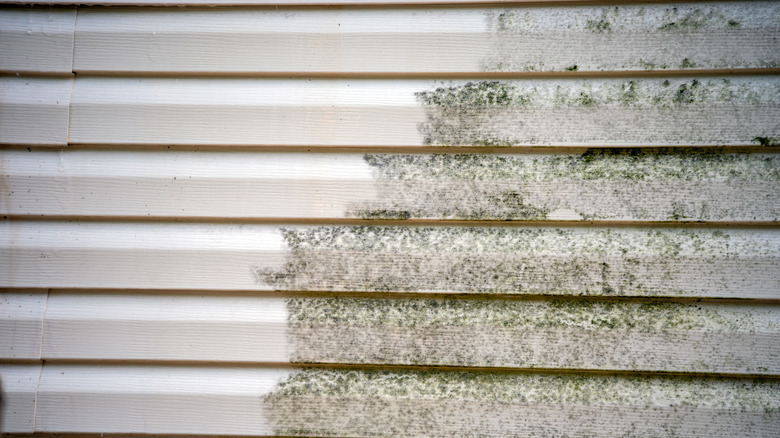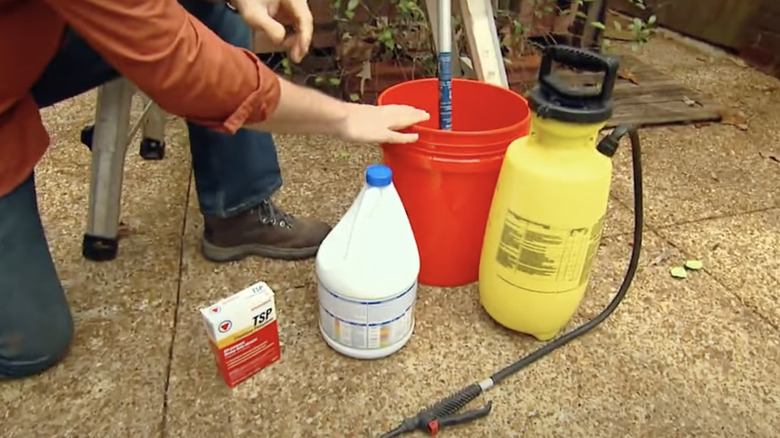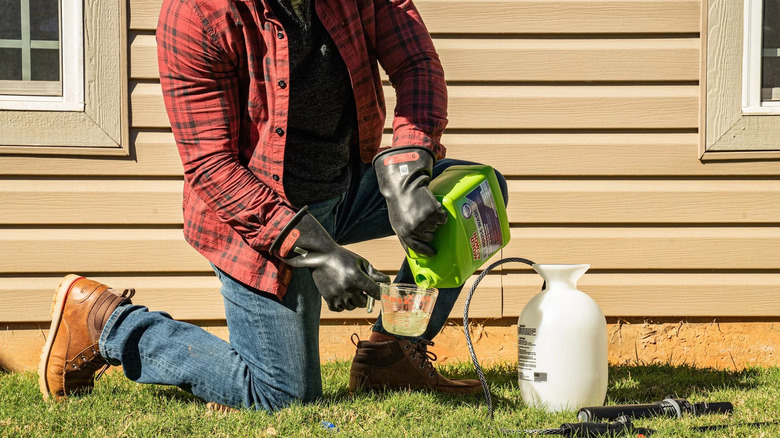Exterior Mildew Doesn't Stand A Chance Against This Easy DIY Solution
Mildew develops quickly on the home's exterior when walls get wet and don't dry fast enough and thoroughly. Homeowners can deal with mildew issues more frequently during the winter season when there is limited sunlight and high chances of rain or snow. If you're noticing mildew growth along your walls or siding, removing it before it spreads and becomes more complex to eliminate is best. Even though you might clean your exterior siding once a year, it's vital to keep an eye on your home to catch early signs of mildew growth. On the off chance that you have mildew on your exterior, DIYing a solution that involves bleach can help remove it.
Bleach is a household favorite used to whiten and brighten clothing and stained surfaces. It can help clean exterior materials, such as cement, Hardie plank, stucco, brick, etc. You don't want to leave mildew untreated for too long, or else it'll turn into mold, which can cause significant issues. Even though bleach can treat mildew, it's crucial to take caution when using it around your house. If misused, it can harm plants, animals, children, and yourself. You always want to wear gloves and boots when handling a bleach solution. And since you'll be using the solution outside, it's possible that bleach can end up on your plants, so it's best to give them a rinse when you're done scrubbing the mildew. Regardless, this bleach solution will work wonders for your exterior and only requires a few ingredients.
Creating your bleach solution
You'll need Clorox disinfecting bleach, which costs $8.38 at Walmart, a gallon of warm water, a bucket, and a long-handle scrub brush. In your bucket, combine a gallon of warm water with ⅓ cup of bleach and mix. Clorox recommends spot-testing a small hidden area on your exterior to ensure it reacts well with the bleach. If you don't see any issues arise, apply the solution to the entire surface. On the other hand, you can use detergent and an alkaline cleaner, such as washing soda, in your solution for a boost of extra cleaning. Walmart sells washing soda for $5.38 if you don't have some at home. You'll need to combine ⅓ cup of all-purpose laundry detergent, 12 cups of warm water, 4 cups of bleach, and ½ to ⅔ cup of washing soda.
Before applying the solution to your home's exterior, cover your plants with a plastic sheet to prevent getting bleach on them. Then, prep the surface by spraying it down with water. Dip the long-handle scrub brush into your solution and scrub the mildewed surface. Continue dipping and scrubbing the surface until it's practically soaked. The surface needs to stay wet for about 10 minutes for the solution to activate. Once the time is up, rinse the wall with water, and you should notice mildew residue slide down the surface. Allow the area to completely air-dry. Finally, remove the tarp from your plants and water them to wash away any bleach that could've slipped through.
Alternative to using potent bleach
Disinfecting bleach includes downsides like harming plants and animals and staining clothes, so if you want to take safer precautions, you can use a bleach cleaning alternative ingredient that will still give you great mildew-eliminating results. For instance, oxygen bleach is similar to regular bleach in that it removes mildew, but it's non-toxic and safe to use around your plants and animals. Oxygen bleach is slightly more expensive than regular bleach, yet it's a better alternative to prevent strong smells and burning eyes.
Further, disinfecting bleach only removes mildew from the surface; it doesn't always penetrate deep into the pores. However, oxygen bleach will attack the bacteria's cell wall, killing the mildew spores. You can purchase oxygen bleach at Walmart, which has Mold Armor Liquid House Wash for $13.97. You can use this product as is, following the instructions, or purchase a powder version and mix it with warm water, following a 1 to 1 ratio, to create a solution. The routine is the same as with disinfecting bleach, wherein you prep the surface with water, apply the solution with a scrub brush, and let it air-dry after rinsing. The only difference is that you're using a safer, non-toxic ingredient. Plus, if you decide to paint your home's exterior, oxygen bleach is more effective at removing mildew than regular bleach, and it will prevent regrowth through the paint. So instead, you'll have clean, painted walls.


